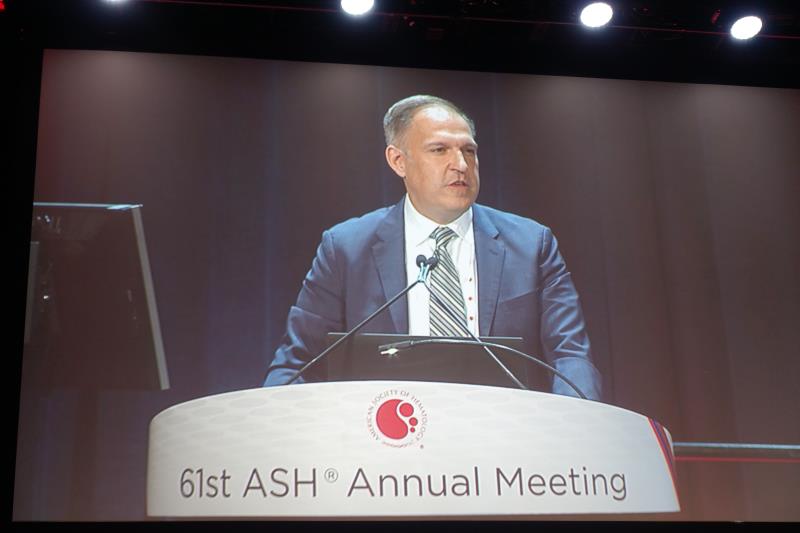 Dr Peter Voorhees
Dr Peter VoorheesThe addition of daratumumab to lenalidomide, bortezomib, and dexamethasone (RVd) significantly improves response rates and depth of response in patients with newly diagnosed multiple myeloma (NDMM) who are eligible for an autologous stem cell transplant (ASCT), according to updated results of the phase II GRIFFIN* study presented at ASH 2019.
The participants were 207 patients (median age 60 years) with NDMM who were ASCT-eligible (ECOG score 0–2 and creatinine clearance ≥30 mL/min). They were randomized to receive either daratumumab with RVd (D-RVd**; n=104) for cycles 1–4 (induction phase) and cycles 5–6 (consolidation phase), followed by daratumumab-lenalidomide (D-R***) for cycles 7–32 (maintenance phase) or RVd only (n=103) for a 21-day cycle (induction and consolidation phases), followed by lenalidomide (R#) alone for a 28-day cycle (maintenance phase). Patients underwent stem-cell mobilization and transplantation before the consolidation cycle. [ASH 2019, abstract 691]
More patients who received D-RVd achieved stringent complete response (sCR) by the end of consolidation compared with those who received RVd (42.4 percent vs 32.0 percent; odds ratio [OR], 1.57, 95 percent confidence interval [CI], 0.87–2.82; p=0.068). “This [result] was, technically speaking, statistically significant as defined by the protocol,” said Dr Peter Voorhees from the Levine Cancer Institute at Atrium Health in Charlotte, North Carolina, US.
After a median follow-up of 22.1 months, significantly more patients in the D-RVd arm achieved an sCR than those in the RVd arm (62.6 percent vs 45.4 percent; OR, 1.98, 95 percent CI, 1.12–3.49; p=0.0177), with an overall complete response rate of 79.8 percent vs 60.8 percent (OR, 2.53, 95 percent CI, 1.33–4.81; p=0.0045). “With longer follow-up, we can see that the responses have deepened over time in both arms of the study, but the D-RVd arm continues to perform better [at all time points],” Voorhees noted.
Using next-generation sequencing, researchers found that a higher proportion of patients in the D-RVd arm achieved minimal residual disease (MRD)-negative status compared with those in the RVD arm (51.0 percent vs 20.4 percent; p<0.0001).
At 24 months, the estimated PFS rates in D-RVd vs RVd recipients were 95.8 percent vs 89.8 percent, while the OS rates were 95.8 percent vs 93.4 percent.
Grade 3/4 neutropenia (41.0 percent vs 22.0 percent) and thrombocytopenia (16 percent vs 9 percent) occurred more frequently in the D-RVd arm compared with the RVd arm, which was expected, said Voorhees. Any-grade infection rates were also higher in the D-RVd than the RVD arm (91 percent vs 62 percent).
“[T]he overall safety profile of D-RVd is consistent with previous reports of daratumumab plus standard of care,” Voorhees said, noting that the addition of “daratumumab [to the RVd standard-of-care regimen] did not impact time to engraftment [of neutrophils or platelets]”.
“The benefit of [the addition of] daratumumab continues with longer follow-up, as D-RVd shows continued improvement of sCR and MRD-negativity rates beyond post-ASCT consolidation … These results support D-RVd as a potential new standard of care for transplant-eligible NDMM [patients],” he added.
*GRIFFIN: Study comparing daratumumab, lenalidomide, bortezomib, and dexamethasone (D-RVd) versus lenalidomide, bortezomib, and dexamethasone (RVd) in subjects with newly diagnosed multiple myeloma
**D-RVd dosage (induction and consolidation phases): D (16 mg/kg IV for days 1, 8, and 15); R (25 mg PO for days 1–14); V (1.3 mg/m2 SC for days 1, 4, 8, and 11); and d (20 mg PO for days 1, 2, 8, 9, 15, and 16)
***D-R dosage (maintenance phase): D (16 mg/kg IV for day 1 Q4W or Q8W); and R (10 mg PO for days 1–21, cycles 7–9
#R dosage (maintenance phase): 10 mg PO for days 1–21, cycles 7–9; and 15 mg PO for days 1–21, cycles 10+